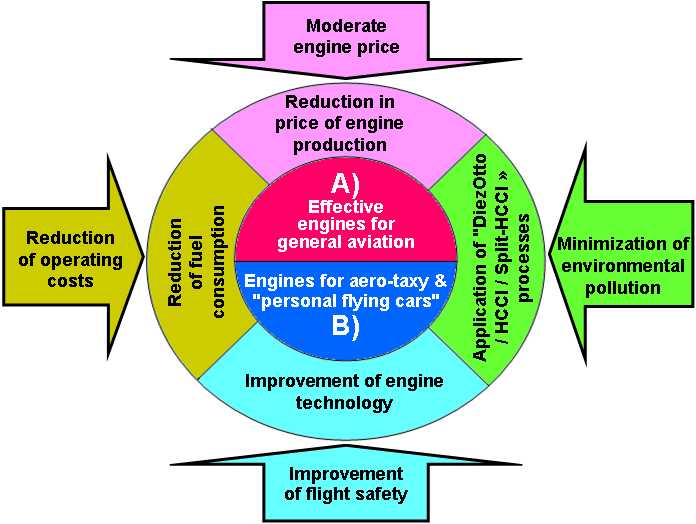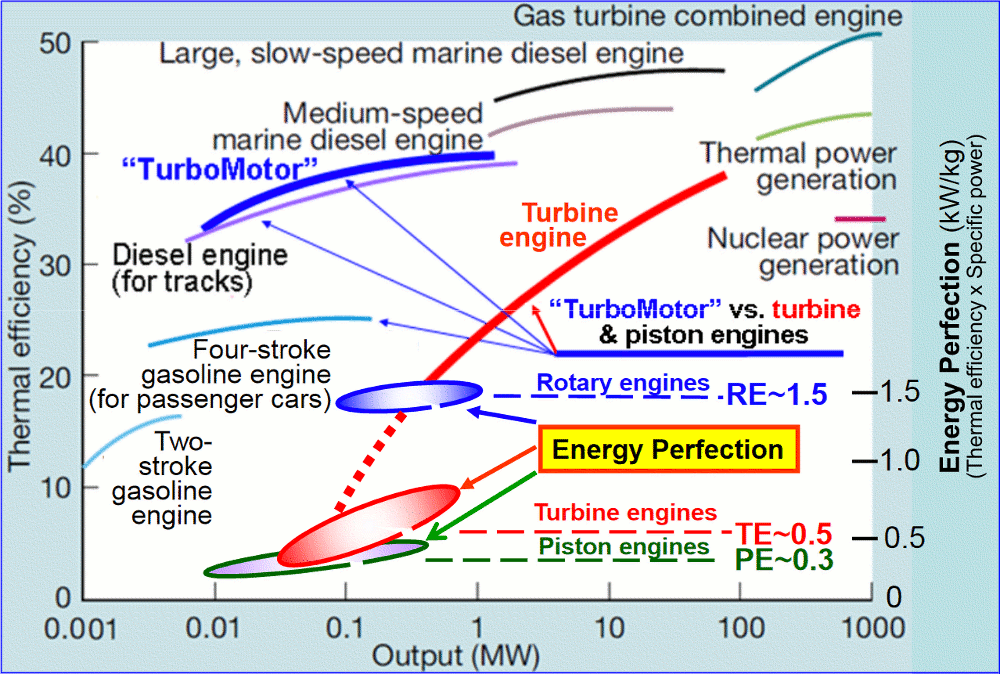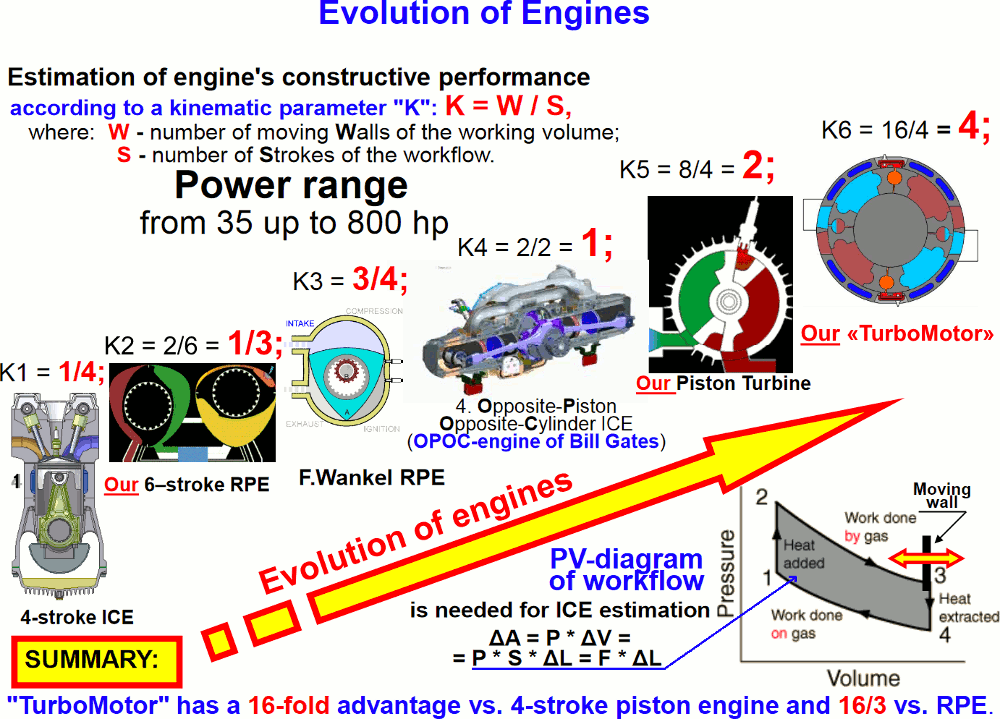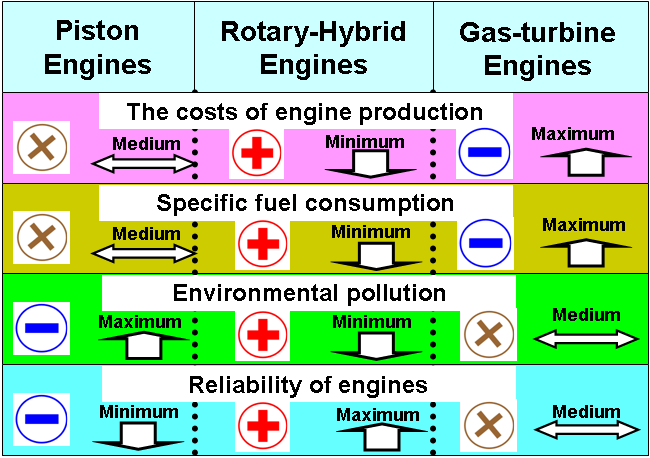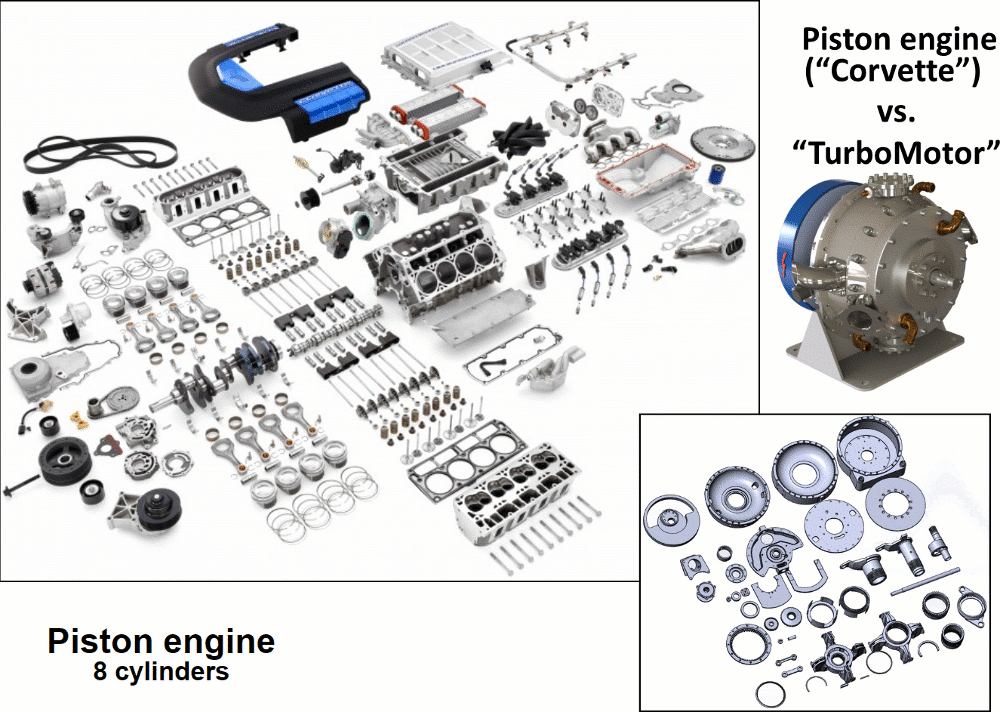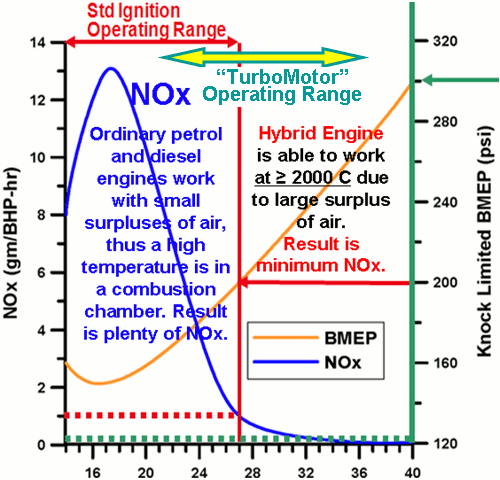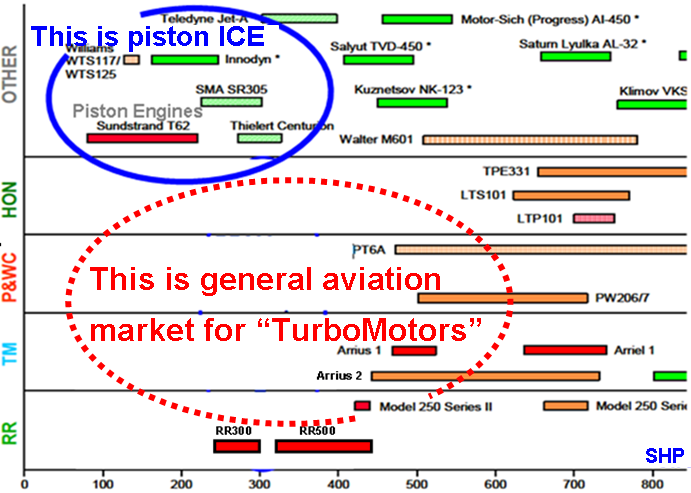Article: Rotary-Hybrid Engines for Small Aircraft
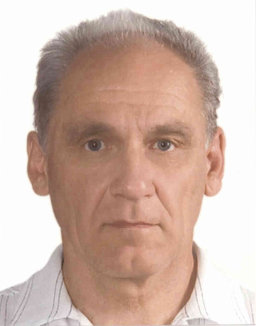 |
Author: Eugene F. Drachko, PhD, Kiev, Ukraine. Сo-founder several commercial structures of engineering orientation since 1992. Founder and director of"TechResource-Motors" R&D Co., Kiev, Ukraine. The main activity of the enterprise is the creation of innovative rotary engines for general application. |
Abstract:
This article discusses the possible ways of innovative development in the transport industry and engine manufacturing in particular (namely the "rotary-hybrid technology "TurboMotor") with goal to the fullest satisfaction to needs of today's market of general aviation with the prospects of opening its qualitatively new market segments in the such forms as inter-city taxis, "flying cars" and so-called “light personal jets”. Creation of “optimal” engines for them is main aim of our “Rotary Project”.
THE FACT: Reciprocating internal combustion engines (ICE) have been invented very long time ago (≈150 years ago), the design of which has been continuously improved, but it has not changed up to this day. The gas turbine engines (GTE) were invented more than 75 years ago, the design of which also has not changed to this day.
However, the sharp rise in prices for hydrocarbon fuels and hard eco-standards, which are of a legislative nature, fundamentally changed the socio-economic situation in the market. There are no combustion engines today which meet to consumers needs by the main technical and economic parameters:
- A Piston engines (PE) is too heavy, bulky and uneconomical for the modern high-tech transport;
- A gas turbines (GTE) is too expensive and too wasteful, besides their jet stream is very noisy;
- The most stringent technical and economic requirements to engines makes demands the general aviation on the full range of their great number, because they combine the requirements of both individual and corporate users.
THE GOAL: The creation a new type of modern combustion engines for mass application, which have to meet such basic requirements of general aviation as:
- Moderateness of engines in the price due to simple design;
- High reliability of engines for ensure of flight safety;
- Low operating costs, especially the fuel economy;
- The highest possible environmental safety during engine operation;
- Opening prospects of qualitatively new market segments for general aviation such as inter-city aero-taxi and "flying cars" with a short / vertical take-off and landing.
THE PROBLEM: The basis of it is yet unresolved "secrets" of imperfections of the existing reciprocating and turbine engines:
- The "secret" of modern piston engines is the necessity of having multiple cylinders / combustion chambers. This makes its design heavy and bulky which comprising a plurality of precision parts and therefore engine becomes expensive in production. Such multi-cylinder design of reciprocator is the necessity due to the fact that it is impossible to obtain a smoothed torque from piston engine with 1 or 2 cylinders. A next "secret" of longevity of reciprocators lies in the fact that 150 years ago the procedure of handling of cylindrical surface was a sole precise technological operation. This circumstance explains the very appearance and longevity of reciprocators at market.
- The «secret» of modern GTE of low power (less than 300 kW) is their very poor efficiency in contrast to the powerful turbine engine (more than 10 MW). Point is that the compact compressor can not create enough pressure in the flowing combustion chamber of small power GTE. For example, the "RR 300" engine by the Rolls-Royce Company has a capacity of 300 hp and it has small pressure 6.2 bars in the flowing combustion chamber compared with the peak pressure 50 ÷ 100 bars in the closed combustion chamber of piston engine. Therefore, in this case there is a small degree of gas expansion during fulfillment their useful work. For this reason, low-power turbine engines have a very poor efficiency - similarly to a steam locomotive (10%) or even less! Another the "secret" of GTE is their very high cost due to the need to use in their design very expensive heat-resistant materials.
- The common "secret" for piston engines and GTE is a significant decrease in their thermal efficiency outside the optimum loading. The mode of the loading in the majority of cases is constantly changing during engine's operation according to the needs of the consumer. The result of this is increasing of fuel consumption and, consequently, the costs for its purchase.
THE INNOVATION: The essence of it is a simple and obvious - it is idea of creating an "optimal" engine, the design of which realizes the positive qualities of ALL existing engines and does not have their specific drawbacks. Obviously, such an "optimal" engine must have:
- The rotary kinematics and circular working volume (for obtaining high power density - similarly to GTE)
- The closed combustion chambers (for a large peak pressure in them in order to get a good efficiency - similarly to piston engines).
The existing piston engines and gas turbines are improving for many decades and have reached a high degree of perfection. So it is for nothing to wait a significant progress in improving their technical and economic parameters. Further, now there is a widespread trend of transition of transport to electric traction (so-called a hybrid drive) in order to reduce operating costs (by minimizing fuel consumption) and to ensure the reduction of environmental pollution by exhaust gases.
For this reason, it makes sense the maximal development of the rotary-hybrid technology which eliminates the fundamental shortcomings of existing combustion engines, including their poor efficiency outside of the optimal load:
- of small GTE (a huge fuel consumption and high noise level at work);
- of reciprocating internal combustion engines (which have a heavy and bulky multi-cylinder design);
- securing of the engine operation only in the optimum load with maximum thermal efficiency through the use of electro-hybrid mode of engine's operation.
1. Principles of operation and design of the engine "TurboMotor".
The uniqueness of the operation principles and design of the "TurboMotor" is originally reflected in its name: "Rotary-Hybrid", which means a harmonious combination of the operation principles and, accordingly, of the technical and performance characteristics the turbine engines (rotary kinematics) as well as the piston engines (closed combustion chambers) of combustion engines:
- Similarly to turbine engines "TurboMotor" has blades of rotors and the outer small combustion chamber(s) in which is constantly high-temperature gas under high overpressure;
- Similarly to piston engines "TurboMotor" has closed combustion chambers in which at the beginning is compressed the air-fuel mixture and then occur the subsequent combustion of the fuel with a sharp increase in the pressure up to 50 ÷ 100 bar. That ensures a high thermal efficiency of almost regardless of the size and power of the engine.
That is, actually "TurboMotor" is similar to gas turbine engine, but the important fundamental difference is that its working process is occur not in flowing volume, but in closed combustion chambers similar to the piston engine. This provides a high working pressure therein and a high degree of subsequent expansion of the hot gas and thus this provides a good thermal efficiency of the motor, which is comparable with the diesel engine.
There is implemented at the level of inventions the solution of two fundamental problems of the rotary engines in the design of "TurboMotor":
- The invention of innovative kinematics for rotational-oscillation drive of rotor blades;
- The possibility of implementing a workflow of rotary engine with different ways of ignition the fuel-air mixture:
- From electric spark (similarly to Otto petrol engine);
- From compression (similarly to diesel engine);
- From flame torch from of small outer combustion chambers.
The workflow with torch ignition is clearly shown on a video below:
The design of "TurboMotor" is protected by the PCT procedure by several patents of Ukraine, Russia and the United States of America.
 |
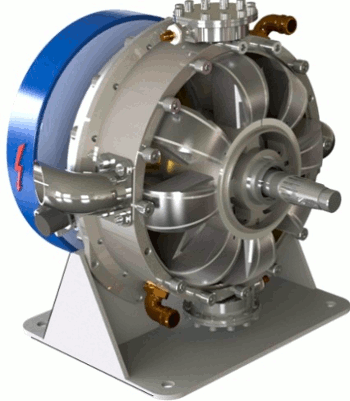 |
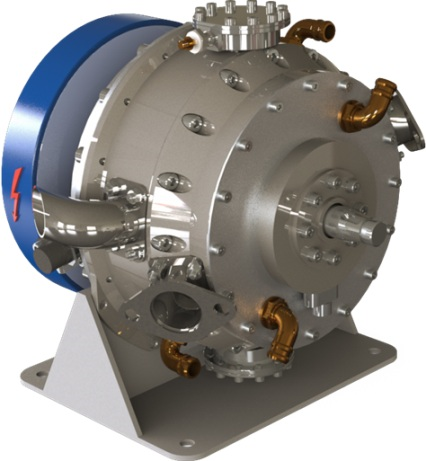 |
Fig.2. Scheme of operation and design of the engine "TurboMotor"
2. Comparative numerical estimation of "TurboMotor"
2.1. Evaluation of ICE according to parameter “Energy's Perfection”
The Figure 3 shows a vivid comparison of the efficiency of heat energy conversion into useful work of engines and power plants of various types depending on their capacity. Here the efficiency value "TurboMotor" is shown somewhat more (≈ 40%) in comparison with a diesel engine. This is due to the fact that one and the same cycle of Diesel engine can fulfilled in both cases, but the mechanical losses due to internal friction in "TurboMotor" is less due to the fact that the its useful work is done by the rotor blades on both sides at once, and in a piston engine it is done by only one top-side of the piston.
It is necessary to pay attention here to the catastrophic decreasing in efficiency of gas turbine engines with a decrease in capacity. Turbine engines with a power of less than 300 kW are comparable with thermal efficiency of the steam locomotive or even less! This is some sort of a paradox of modern engines: powerful GTE are the pinnacle of modern technique but their low-power analogues are lagging in value of efficiency up to 100 years old!
The "secret" of this paradox is determined by the laws of physics, i.e. practically impossible in low-power GTE to provide a high pressure ratio in flowing combustion chamber with the aid of a compact compressor and, accordingly, to have a good thermal efficiency.
Fig3. Efficiency and parameter “Energy’s perfection” of various engines
(referense: "Approach to High Efficiency Diesel and Gas Engines" by Tatsuo Takaishi and others) local copy
The perfection of combustion engine energy's design is advisably to assess simultaneously by two main parameters:
- in terms of thermal efficiency
- according to specific capacity to the weight.
Obviously, if is larger the value of thermal efficiency and power densities, the greater will be the efficiency of commercial implemented technical capabilities of ICE. Therefore, the engine's parameter which is multiplication of the engine's thermal efficiency to it specific weight power can be called as "Energy's perfection of ICE". The average power density GTE as well as the "TurboMotor" are ~ 5 hp / kg (~ 3.7 kW / kg) and of piston engine ~ 1 hp / kg (~ 0.73 kW/kg). We take the average efficiency for reciprocating combustion engines ≈30% (between Otto petrol engine and diesel engine), for the "TurboMotor» ≈ 40% and for low-power GTE ≈10%.
- Piston engine: EPE = ~ 0.3 * 0.73 kW / kg ≈ 0.22 kW / kg;
- GTE: EGTE = ~ 0.1 * 3.7 kW / kg ≈ 0.37 kW / kg;
- "TurboMotor": ETM = ~ 0.4 * 3.7 kW / kg ≈ 1.48 kW / kg.
Fig.3 shows the values of this parameter in the form of oval areas of different colors: PE - lilac, TM - blue, GTE - red. I.e. "Energy’s Perfection" of “TurboMotor” is ≈ 1.48 / 0.37 = 4.0 times better compared to GTE and it is ≈ 1.48 / 0.22 = 6.7 times better vs. piston engines.
2.2. Evaluation of ICE according to the parameter "Design's perfection".
The apparent shortcomings of the existing ICE encourages many professionals and just minded people to the invention of engines, which in the world of science are called as "machines of volumetric expansion", i.e. engines with closed combustion chambers. And of course, each of the inventors extols the virtues of his invention, forgetting about its shortcomings. Therefore, there is necessity for investors and for potential business partners in an objective and science-based quantitative assessment of the innovative internal combustion engines. In this case, the conception of such an assessment should be clear and easy to understand even by non-specialists.
The "TechResource-Motors" R&D Co. has developed and offers a generalized simple estimate for practical use. The basis of its conceptual apparatus is classical thermodynamic cycle, which takes place during the motion of one or more movable walls which are changing the current value of the working volume of the engine. An example of such a working cycle of thermal engine is a diagram which is shown at the bottom right corner of the Fig.4. In the coordinates of PV-diagram, the cycle's area has the physical meaning of the work, which is carried out in 1 working volume of internal combustion engine during 1 working cycle, which contains a discrete number of strokes: 2 -, 4 - or even 6 strokes (for example, see engine "6tRPD" on Fig.3). In this case, it should be noted that regardless of the total number of clock cycles cycle internal combustion engine, only one stroke "Working stroke" does useful work, all other cycles are energy-consuming.
In such a way, the parameter "K" (referred as "Design's Perfection") actually determines of the design's efficiency of kinematics which realizes the drive of number «W» movable walls in 1 working volume of the combustion engine for a 1 full cycle, which consist of number «S» strokes:
K = W / S,
where:
K - parameter which is named "Design's Perfection";
W - number of movable walls in 1 working volume of combustion engine;
S - number of strokes in 1 full working cycle of the engine.
Then the value of the "Design's Perfection" will be for:
- 4-stroke piston engine: K4-spe = 1/4;
- 2-stroke piston engine: R2-spe = 1/2;
- 6-stroke RPE: K6-srpe = 1/3;
- RPE of F.Wankel: KRPE = 3/4;
- The OPOC-engine: Kopoc = 2/2 = 1;
- Piston Turbine: KPE = 8/4 = 2;
- TurboMotor: KTM = 16/4 = 4.
Therefore, the "TurboMotor" has a 16-fold advantage vs. 4-stroke piston engine and 16/3 vs. RPE.Thus, the unbiased comparative quantification of "TurboMotor" with existing combustion engines according to parameters "Energy's Perfection" and "Design's Perfection" shows that it has undeniable and multifold advantages over the existing combustion engines. This apparent advantage of "TurboMotor" is the result of realization of the idea of an "optimal" combustion engine as a synthesis of the positive qualities of all existing engines and the exclusion of their specific weaknesses. The realization of the idea of an "optimal" engine is graphically and clearly illustrated in Fig.5 in the form of Σ "+" in the column "Rotary-Hybrid Engines".
3. Moderate engine price
The Modern turbine engines are 3-5 times the price of piston engine of similar power primarily because of the high prices of heat-resistant materials, which are used in their design. For this reason their application in general aviation, including for replacement of piston engines, is very difficult for practical implementation.
The piston engines for aircraft are 3-5 times more expensive vs. automotive vehicles of the same capacity due to their high cost of certification and expensive maintenance with using specific materials and instruments.
"TurboMotors" have 2-3 times less number of parts (see Fig.6) and they do not contain expensive materials and therefore they are cheaper to manufacture.
There is R&D work done for creating an optimal and standard "TurboMotor" design for decreasing production costs. As a result of this work there is opening the possibility the production of "TurboMotors" of standard design of wide power range (from 90 to 380 kW) on the basis of 3 sizes of kinematic mechanisms (Fig.7). The physical base of such a possibility is the next. The power of any combustion engine is proportional to the working volume. The power of reciprocating engines can be increased by adding an additional amount of cylinders, i.e. in this case the increasing of power is linearly. For the case of the "TurboMotor", which has only one working volume, linear changing of housing sizes provides a changing of its working volume at CUBIC dependence. Accordingly, the changes working volume and power of "TurboMotor" are depending on the cubic function, which is much bigger vs. linearly law of increasing a cylinder's amount. The using of turbocharging allows much to extend this power range.
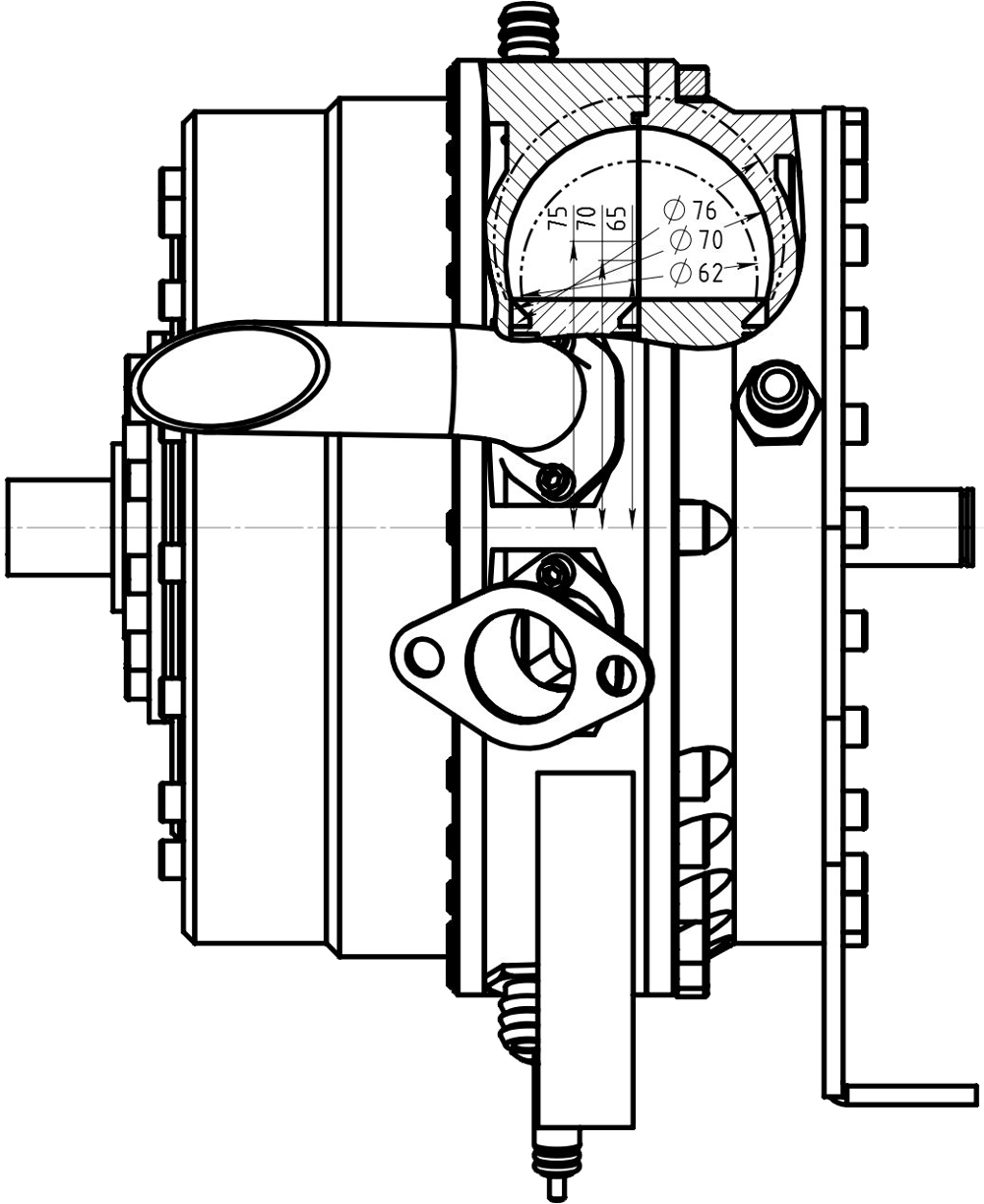 |
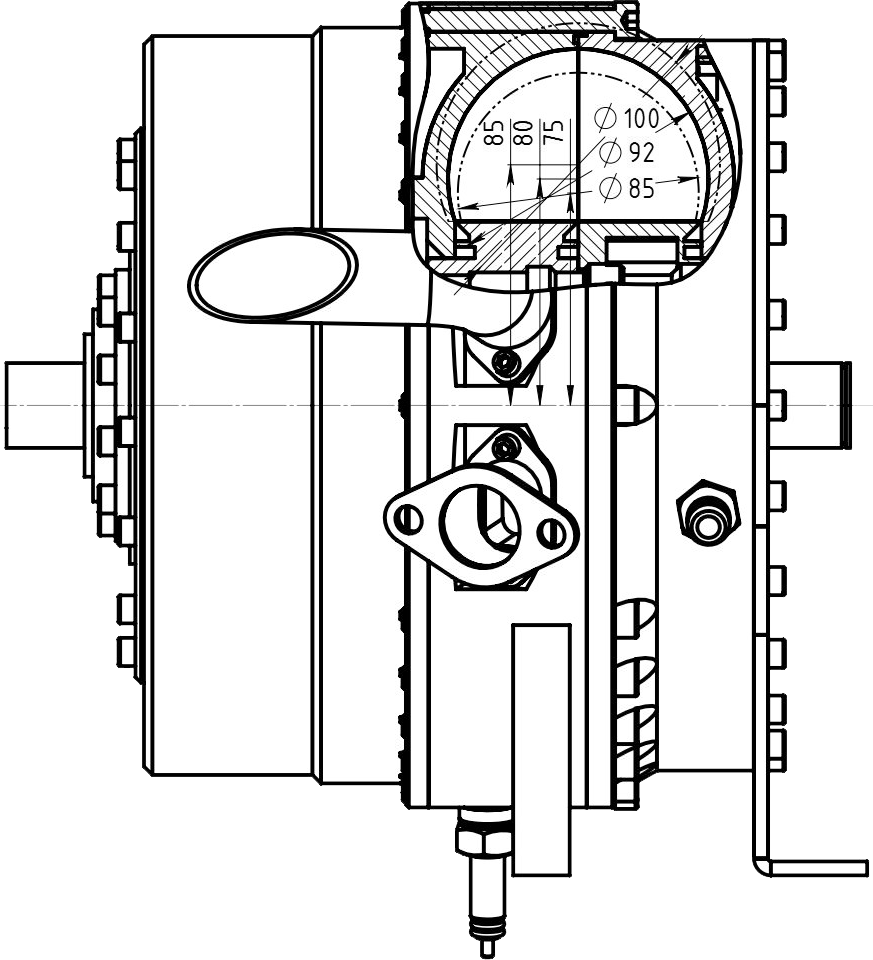 |
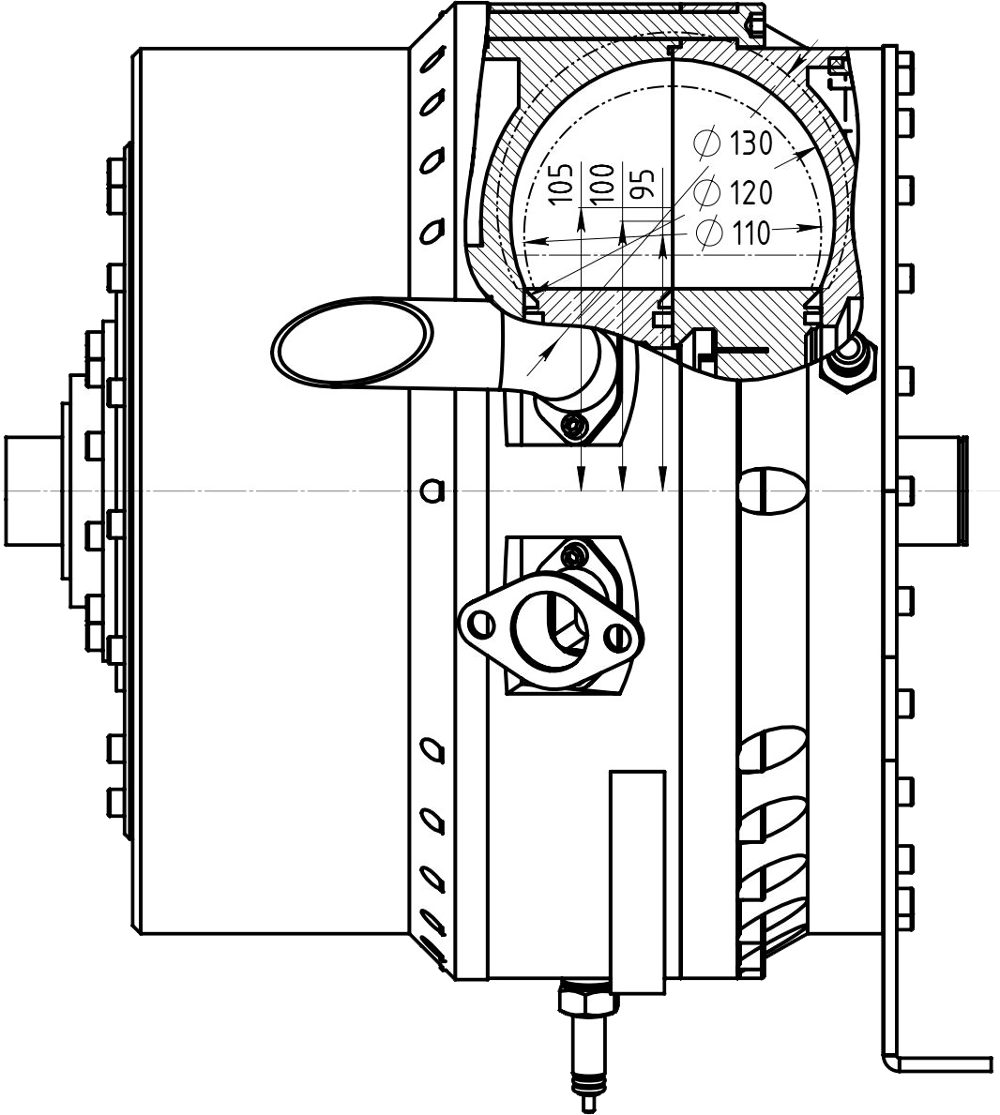 |
|
«A»: 90 / 120 / 150 kW |
«В»: 180 / 220 / 250 kW |
«C»: 270 / 330 / 380 kW |
Fig.7. 3 standard types of kinematic mechanisms of RHE for the power range from 90 to 380 kW
4. Providing of flight safety
The flight safety of general aviation is directly dependent on the reliable operation of the engines. Rotary-hybrid propulsions are more reliable than reciprocators and turboprops because they have fewer moving parts. More over, “TurboMotor” and electric motor are two rotary machines which ideally connected. Therefore electro-rotary-hybrid propulsions are much more reliable than turbine engines and piston engines due to presence two engines in single propulsion unit (rotary combustion engine and electric motor) which able to work separately or jointly. Two inexpensive rotary-hybrid propulsions for modern aircraft instead of one piston's or turbine's engine is a significant contribution to the safety of flights of planes and light helicopters so this broadens its application over urban areas.
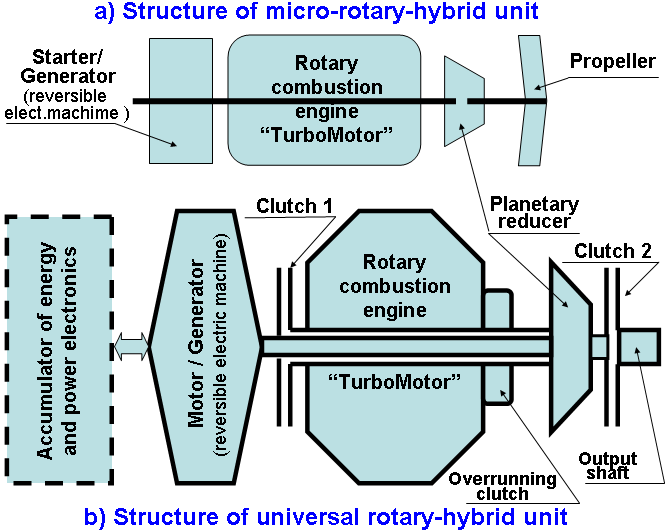
Fig.8. Schemes of micro- and universal rotary-hybrid engines
5. Environmental aspects
Today, particularly important factors is the need to minimize environmental pollution from human activities. Minimum release of environmentally harmful substances during engine work is possible with implementation working cycles with using progressive thermodynamic processes such as DiezOtto / HCCI (Homogeneous Charge & Compression Ignition) / Split-HCCI - in ICE as well as ignition from flame torch due to the feasibility of "TurboMotor" to operate with lean air-fuel mixtures. In this case there is a significant amount of excess air in the fuel-air mixture, so the peak temperature in the working volume of the engine does not exceed 2,000 degrees Celsius. For this reason almost no formation of harmful oxides. So it is possible to use "TurboMotor" without expensive exhaust catalysts. It is makes vehicle design much easier, cheaper and lighter.
6. “TurboMotors” for rotary-fans.
Hitherto aviation fan-propulsions are created only on the basis of turbine engines due to their compactness and high power density, for example PW V2500, PW800. But for general aviation is needed engines with low power (100 kW - 500 kW) and a small thrust (up to 5000 H). However, low-power GTE have huge specific fuel consumption (for example RR300). This situation prevents their widespread use in general aviation. "TurboMotor" has superiority in all the technical and economic parameters vs. low-power GTE, especially to the specific fuel consumption. This opens up the prospect of creating efficient and accessible for the price rotary-fans on the "TurboMotor" basis.
“TurboMotor” has very compact design - it is ~2 times less by the size vs. the piston engines of the same power (see Fig.10). This allows creating the economical rotary-fans on basis of “TM” (Fig.11), which has dimensions like the turbofan engines and practically the same thrust for the same power.
The advent of rotary-fans will create a real basis for the development and the mass production:
- Inter-city aero-taxi;
- The real "flying cars" of short / vertical take-off and landing.
- So-called “light personal jets”.
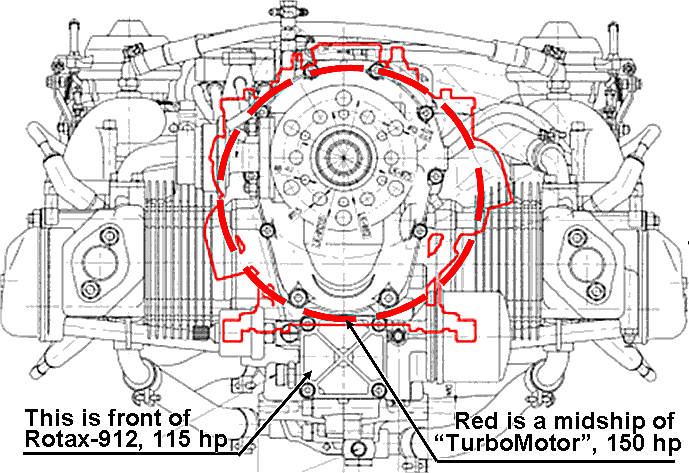 |
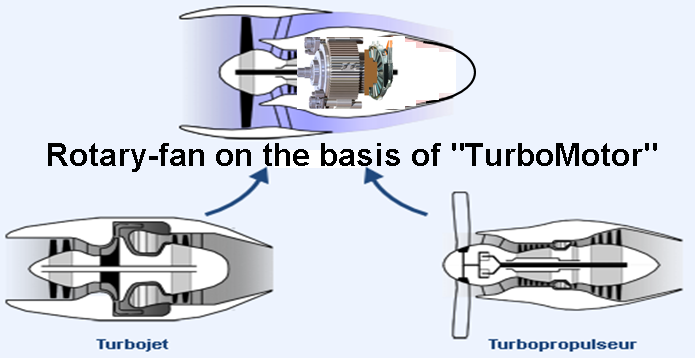 |
|
Fig.10. Front of Rotax-912 vs. “TurboMotor” |
Fig.11. Rotary-fan on the basis of “TurboMotor” |
7. Market opportunity
There is a sharp need for efficient and eco-friendly engine's family for general aviation with power range from 120 kW up to 500 kW worldwide. These categories of propulsion units are also widly used as auxiliary power units (APU) for regional aircraft, helicopters, medium and large passenger and cargo aircraft for their autonomous power supply.
Currently, General aviation has no engines which are adapted to their needs: piston engines are too heavy and bulky and GTE are too expensive and have huge fuel consumption. An “optimal” rotary-hybrid engines "TurboMotor" can fully meet the needs of a modern general aviation in the power range from 120 kW up to 500 kW. It is this range of power has the most demand by the modern general aviation and automotive industry.
8. Estimation of technology readiness level (TRL)
The International Standard AS / EN 9100 established the 9 basic technology readiness levels (TRL). We have done work on assessment of technology readiness level "TurboMotor" with respect to data of 30.04.2013. In particular, we have made the next sections of "Classification":
- TRL 1. Basic principles observed and reported
- TRL 2. Technology concept and/or application formulated
- TRL 3. Analytical & experimental critical function and/or characteristic proof-of-concept
- TRL 4. Component and/or breadboard validation in laboratory environment
To date, technology readiness of rotary-hybrid engine "TurboMotor" (prototype has power of 150 hp) we estimated about 30 ÷ 35% (see Fig.13). A full report on the technology readiness level has 64 pages. It should be emphasized it is the scientific and engineering beginning of prospective "Rotary-hybrid technology "TurboMotor" which can and should be the basis of industrial rotary-hybrid propulsions of various power for the transportation industry.
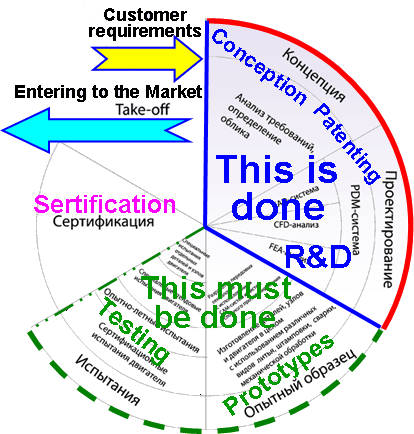
Fig.13. Technology readiness levels.
CONCLUTION:
The "TechResource-Motors"R&D Co for many years is developing the concept of "optimal" engine for general applications. The result of this is creation of conception of Rotary-Hybrid Technology "TurboMotor", the essence of which is briefly summarized here.
This article provides a comparative quantitative evaluation of technical and economic efficiency of engines of different types and here is shown multifold advantage of the "TurboMotor" over other existing motors according to such generalizing criteria:
- "Energy's Perfection" compared with:
- Reciprocating engines - ≈ 6.7 times;
- Gas turbine engines - ≈ 4.0 times;
- "Design's Perfection" compared with:
- 4-stroke piston engines - 16 times;
- Rotary-piston engines of F.Vankelya - in 16/3 times;
- The OPOC-engine by the "EcoMotor" company, USA, - 4 times.
"TurboMotors" can and should be the basic components as conventional mechanical as well hybrid propulsion systems for creating publicly available light aircraft of different aerodynamic schemes, which are using different aerodynamic effects including such as air-cushion support and modern aerodynamics of vortexes:
- Economical light “car-helicopters”;
- Inter-city aero-taxi;
- The real "flying cars" of short / vertical take-off and landing;
- So-called “light personal jets”.
The some experimental works are done already in this direction in Ukraine. However, the main obstacle to their further successful progress was the lack of combustion engines with high technical and economic indicators. Only with the advent of "TurboMotors" will be a reality the creation of a real publicly available "flying cars" for everyday use. We have effective solutions in this area which can be patented.





